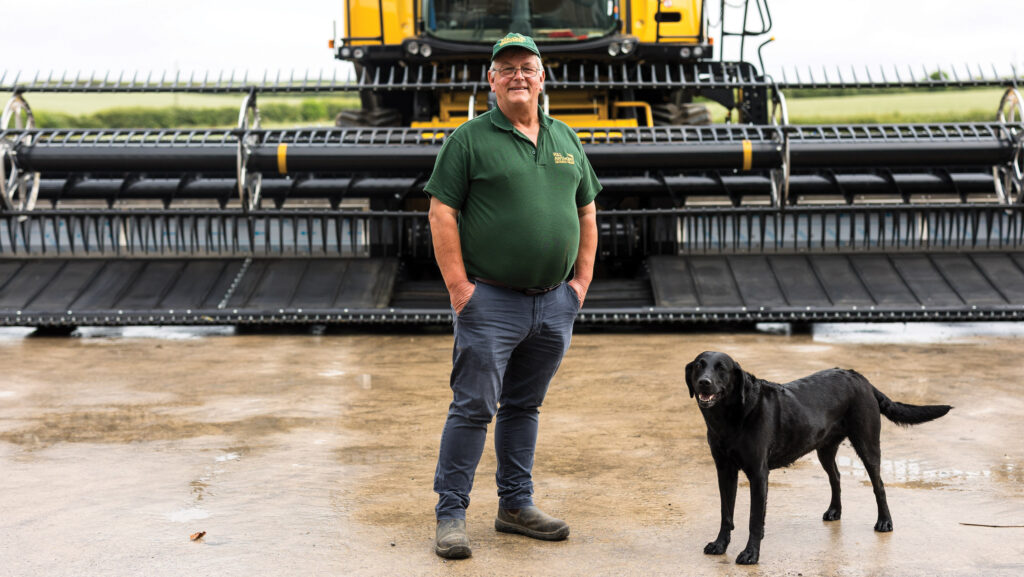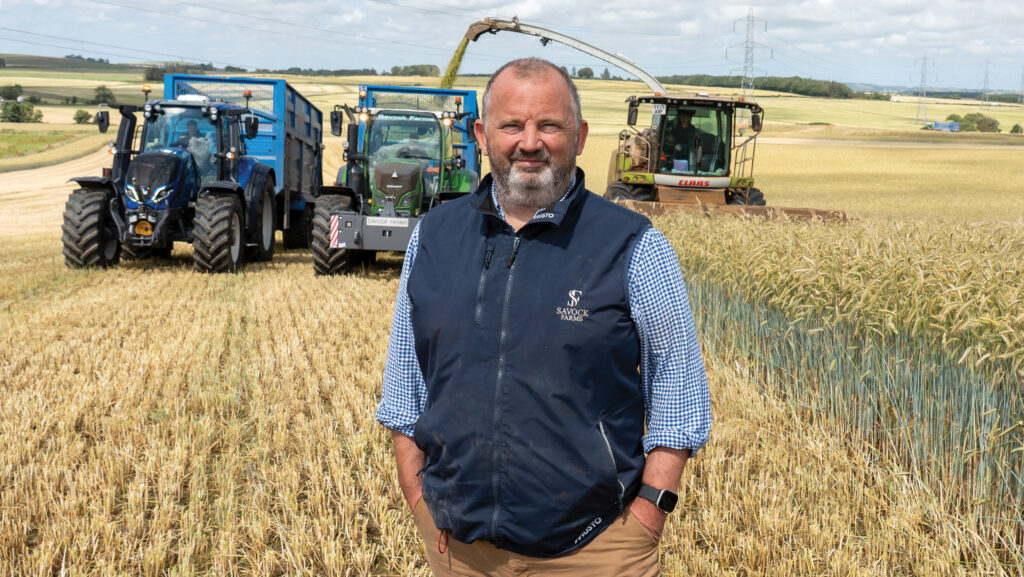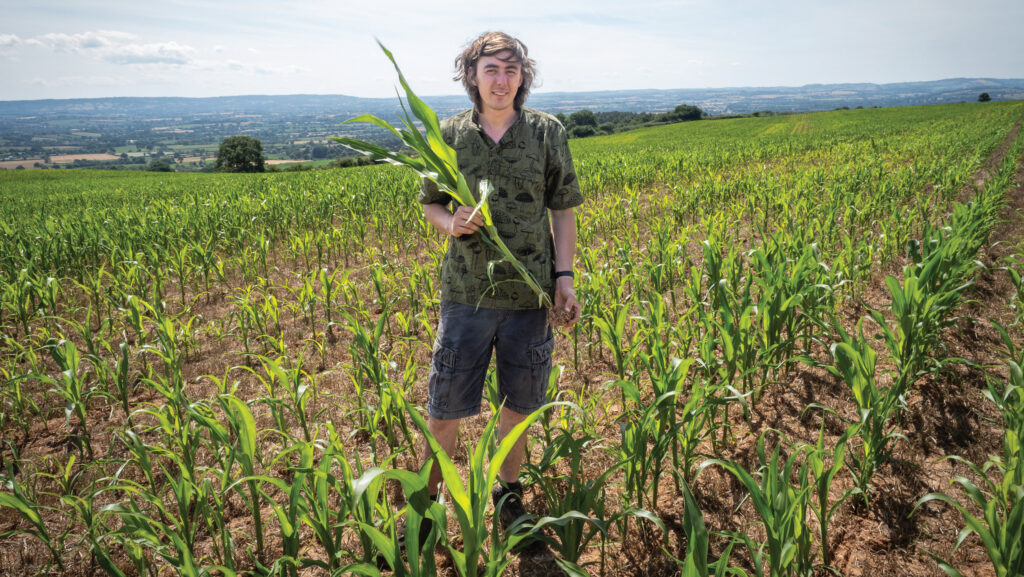FW Awards: Meet the 2025 Arable Farmer of the Year finalists
 From left: Richard Anthony, Andrew Booth and Charles Quick © John Wellings, Angus Findlay, Kathy Horniblow
From left: Richard Anthony, Andrew Booth and Charles Quick © John Wellings, Angus Findlay, Kathy Horniblow Three finalists – from England, Scotland and Wales – are focused on improving soils and making land more productive.
Finalists
- Richard Anthony, Tythegston Farm, Bridgend
- Andrew Booth, Savock Farms, Aberdeenshire
- Charles Quick, Keirles Farm, Somerset
The judges
- Jonathan James – Independent judge and AICC agronomist at CCC Agronomy in Chichester, advising farmers within West and East Sussex.
- Mark Means – Last year’s Farmers Weekly Farmer of the Year farms 729ha near Kings Lynn. Crops include potatoes, sugar beet, vining peas and winter wheat.
- Richard Allison – FW’s arable editor is from a farming background, and has been with the magazine since 2001.
Richard Anthony, Tythegston Farm, Bridgend

Richard Anthony © John Wellings
Rainfall that tops 1,448mm a year and fields running right up to the South Wales coast are tough conditions to grow high-yielding cereal crops.
However, Richard Anthony and his wife, Lynn, are doing just that and have earned a reputation among local landowners for turning around unproductive land.
Their success could be seen this summer, with oilseed rape yields in some fields well in excess of 6t/ha.
Challenges
Richard started out as a livestock farmer renting land and then, in 2001, he embarked on arable farming.
In the years since then he has developed a system that can cope with the extreme wet weather.
Harvesting crops is a key challenge and a study tour of Aberdeenshire offered some pointers.
“All the farmers we visited either had a biomass boiler for drying or were about to put one in and cut up to 35% moisture,” he says.
This allows crops to be harvested at a higher moisture. “You have to get on as soon as crops are fit to maintain quality.”
To make the most of dry spells, he runs a high-capacity New Holland CR9.90 rotary combine with a MacDon Draper header.
Another challenge was improving the depleted soils, some of which had organic matters as low as 1% when he took the land on.
Cropping system
Richard widened the rotation and added organic matter using turkey muck and digestate.
He ensures there are always roots in the ground with cover crops and rye on heavier ground before maize.
Compaction is minimised by running tractors and kit with low tyre pressures and using 24m permanent tramlines.
Cultivations have also been reduced by strip-tilling OSR and direct-drilling other crops where possible.
Not all fields are suited for maize growing, so he runs two rotations.
Nine crops are grown in six years by double cropping maize and Westerwold rye with wheat and OSR as combinable crops.
He runs a four-cut system on the Westerwold rye producing 8,000-10,000t of forage and hay.
The rye also offers winter sheep grazing and is helping to tackle a sulfonylurea-resistant ryegrass problem.
Septoria is the top threat and he selects varieties with insights from the trials he hosts as breeders put wheats through their paces. He is also prepared to invest in the latest fungicides.
The final challenge is salt burn. Richard recalls losing 61ha of wheat one year. Narrower row spacings to keep crops standing, higher seed rates and silicon, which helps harden cell walls, have helped reduce the risk.
Results
The result is that yields are rising. “We were struggling to hit 7.4t/ha and now the rolling average for wheat is close to 9.9t/ha. OSR is averaging 4.8t/ha and maize 42-45t/ha.”
Soil organic matter has increased, with fields now averaging 6-8%.
The combination of reduced cultivations, dramatically cutting fertiliser, and using renewable energy to dry grain means he has cut his carbon footprint. In 2021-22, his farm sequestered 50t/ha carbon.
Richard is making the most of local markets, with his maize grown for a dairy farm and wheat sold to a mill fetching a small premium.
He also sells clamp silage (wrapped) to local farmers. Barn-dried hay, using heat from the biomass boiler in the drying floor, is being sold for racehorses in northern England.
Richard feels there will be scope to expand in the future, as many farmers look to retire in the area.
He has transformed unproductive land and proved you can achieve double-digit wheat yields in the very high rainfall area.
The numbers
- 9.9t/ha rolling five-year average wheat yield
- 43t/ha average maize yield
- 400 seeds/sq m starting wheat seed rate along coast to cope with salt burn
- 50 carbon balance (carbon dioxide equivalents t/year) for each hectare
- 180kg/ha of nitrogen applied to wheat crops as digestate
Farm facts
- Area: 1,370ha of arable cropping
- Cropping: Winter wheat, oilseed rape, maize forage rye/Westerwolds, Italian ryegrass and cover cropping
- Establishment: Establishment: Mzuri Protil 4m strip-till drill for OSR, 6m Horsch Avatar disc drill
- Soils: Shallow soils, ranging from sands to heavy clay
- Staff: Richard and Lyn, plus five staff
What the judges liked
- A first-generation farmer who has achieved a lot in that time
- Good-looking crops, especially OSR
- Top of his game on soil management
- Biomass heat benefits both grain and forage enterprises
- Adoption of technology such as variable seeding
What the judges say
A first-generation arable farmer, Richard has achieved a huge amount in that time and is top of his game on soil management.
We liked how he was extracting the most value out of the biomass boiler, benefiting the whole business.
Andrew Booth, Savock Farms, Aberdeenshire

Andrew Booth © Angus Findlay
Growing crops for an anaerobic digestion plant and developing a gluten-free oats market means Andrew Booth has reduced his arable farm’s exposure to commodity markets.
Five years ago, he recalls the business was treading water, so the family decided to close the farm shop, sell off the cattle and focus solely on arable, creating a leaner business.
Since then, he has created a cropping system that is making the challenging land he manages more productive.
Grass and rye focus
A key part of Andrew’s approach to improving the land is treating grass leys as an arable crop.
They enable the liberal use of digestate in the wetter north with less risk of soil compaction. Compaction risk is also minimised by running low tyre pressures.
The digestate comes from the anaerobic digester, which the farm is contracted to feed with energy crops. “It’s effectively our livestock,” he says.
It is too cold to grow maize so far north, so winter rye is the energy crop. Like the grass leys, it receives liberal amounts of digestate.
Cropping system
Andrew runs two separate rotations: one is three years of grass, followed by three years of winter/spring oats in a dedicated gluten-free rotation.
The second rotation is eight years with OSR and grass used as break crops for the cereals, which include wheat, spring barley and winter rye.
Establishment is based on a 6m Pottinger disc drill, plus a 4m power harrow Amazone combi drill.
Cultivations include rotational ploughing before oats and spring barley, and min-till for winter cereals. “You need all options as weather windows are very short for drilling,” he says.
Variable seeding is also key to establishment as he looks to create an even biomass, which aids with crop management.
He is an enthusiastic advocate of technology, such as NIR spectroscopy on the umbilical slurry applicator to measure the nutrient content of digestate as it is applied.
He is also one of the first to adopt yield mapping on the forage harvester.
Andrew recalls his frustration at not having yield maps when growing anaerobic digester crops (rye), while having combine data for combinable crops.
Now, armed with this data, he is looking to better match nutrient application in digestate with its offtake as forage.
Results
The result of the wider rotation, application of digestate and manures is improving soil health – successfully turning unproductive livestock land into productive arable growing areas.
With the adoption of lean management principles, Andrew set a target of raising yields by 20% over five years, and he is on track.
The current five-year rolling average is 9.5t/ha, compared with an 8.9t/ha average in 2021.
He is also successfully adding value to crops.
Together with another farm, he has founded Scotland’s only accredited gluten-free oat mill targeting markets and is now supplying rolled oats for Tesco’s “free from” range.
With combinable crops, Andrew is earning premiums for distilling spring barley, and wheat is sold to a number of merchants and can earn up to £14/t in distilling premium.
Looking to the future, Andrew aims to further improve yields and expand the area he farms.
And with 60% of crops grown for non-commodity markets, he has successfully created a more resilient business that thrives in the far north of the country.
The numbers
- 9.5t/ha rolling five-year average () wheat yield
- 6% average soil organic matter content. Most fields range 5.5 to 7%
- 7.4t/ha rolling five-year average yield for winter oats
- 20t/ha average amount of digestate applied annually
- 60% of crops grown for non-commodity markets (gluten-free oats and AD)
Farm facts
- Area: 1,850ha
- Cropping: Winter wheat, oilseed rape, winter and spring oats, winter rye, spring barley and rotational grass leys
- Establishment: 6m Pottinger disc drill and 4m Amazone combi drill. Plough plus Simba disc cultivator
- Soils: Clay loams
- Staff: Seven full time, plus seasonal casual
What the judges liked
- Adding value to oats with premium gluten-free market
- Treats all land as if it was his own
- Grass and rye integrated into rotation
- Bringing unproductive land back into production
- De-risking with 60% of crops grown for non-commodity markets
What the judges say
Andrew is a keen user of tech and is successfully bringing unproductive land back into production.
We like how grass and rye are integrated in the arable rotation and how he has helped create a new market for oats.
Charles Quick, Keirles Farm, Somerset

Charles Quick © Kathy Horniblow
While the Quick family has been direct drilling since 1998, Charles has taken the business to another level by slashing inputs without compromising crop yields.
He is pushing the boundaries of regen farming with novel approaches such as direct-drilling pumpkins into standing rye, double cropping maize with rye, and growing oilseed rape without fungicides.
His dad, Andrew, was one of the original direct-drilling pioneers. But it was still a high-input system with a short rotation and, consequently, soil health was suffering.
“Soils were not in brilliant heart by the time I returned [from college], with rampant compaction,” he recalls. So he set out to develop his own regen system with soil health at its core.
Changes
The rotation has become more diverse – moving from the traditional wheat/OSR/wheat to a six-year rotation with the addition of spring cropping (peas and maize), Westerwold rye along with cover and catch crops to ensure soil is never bare.
He is feeding soils with slurry and sewage sludge and, combined with the living roots, organic matters are now increasing by 0.1% a year.
The result is that they are more workable and resilient, with no erosion despite farming on some steep Quantock slopes.
Using manures has also helped him reduce artificial nitrogen fertiliser use, which has fallen from 220kg/ha to 170kg/ha without any yield penalty. Virtually no P and K is bought in.
Pesticide inputs have also been reduced – this year fungicide costs in wheat have been only £32/ha, with use of sulphur and older chemistry.
However, he will still use SDHI fungicides in higher pressure situations.
Charles has dropped fungicides completely for oilseed rape and avoids using herbicides with long half lives, such as diflufenican.
For cultivations, everything is direct-drilled with either a tine or disc drill, according to conditions.
The only cultivation equipment is a low-disturbance subsoiler, which is used before the maize.
These substantial reductions in inputs and cultivations have been achieved without compromising crop yields, with OSR averaging 3.6t/ha and wheat 8.8t/ha, and peas yielding up to 7t/ha.
Business
To maximise income, Charles adds value where possible. This season he is growing blue peas for human consumption instead of feed peas.
Some of the wheat is sold to a nearby caustic treatment plant, earning a small premium, and the maize is sold to a local dairy farmer.
The reintroduction of sheep is bringing in another £200/week for grazing wheat, which helps reduce disease risk.
He has grown the pick-your-own business by adding pumpkins and sunflowers, and the labour requirements fit well with the arable business.
Charles has taken advantage of the Sustainable Farming Incentive, receiving an average £315/ha for actions such as companion cropping, no till and no insecticides.
And if that isn’t enough, he has spun off a small business making GPS autosteer systems which he designed and developed himself.
The units are aimed at helping smaller arable farms benefit from the technology.
Future
While Charles’ output has remained consistent, the fixed and variable costs are much lower than other similar-sized farms, resulting in the arable business punching well above its weight in terms of profitability.
Based on this success, Keirles Farm is in good hands for another 26 years of direct drilling.
The numbers
- 0.1% average increase a year in soil organic matter over past decade
- 8 years since artificial P and K were last used
- 8.8t/ha rolling five-year average of wheat yield
- £140 full growing costs for a tonne of wheat
- 175kg N/ha bagged nitrogen use on wheat crops
Farm facts
- Area: 145ha of arable cropping
- Cropping: Winter wheat, oilseed rape, blue peas, maize, Westerwold ryegrass + clover mix
- Establishment: Establishment: Horizon 6m DSX disc drill, Amazone Primera 6m tine drill and Kuhn Maxima 6m maize drill
- Soils: Shallow sandy, clay loam over free draining shale
- Staff: Charles, his dad plus two casuals for the farm shop
What the judges liked
- Passion for regen farming and soil health
- Runs a profitable arable system
- Prepared to try new things and learn from mistakes
- Good integration of the arable and pick-your-own enterprises
- Novel techniques such as direct-drilling pumpkins into standing rye
What the judges say
Charles has a strong passion for regenerative farming and has created a profitable, low-input cropping system.
We like how he is willing to try new approaches and learn from his mistakes.
A word from our sponsor

“Nitrasol salutes the Arable Farmer of the Year finalists – true professionals that share our passion for innovation, professionalism and teamwork driving exceptional performance and success.”
Lord Fuller, chairman, Nitrasol

